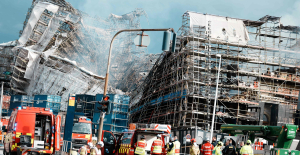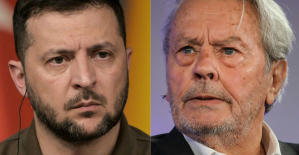“Confident without being overbearing.” This is how architect David Chipperfield is described by Tom Pritzker, chairman of the Hyatt Foundation, which annually awards what is considered the Nobel Prize in architecture: the Pritzker Prize. The 69-year-old Chipperfield has now won it. Of course, the praise for the prizewinner is accompanied by the rhetorical criticism that in the architects' profession self-confidence is all too often coupled with overconfidence.
Chipperfield is one of those architects whose name is known far beyond the industry. However, he celebrates his start with the restraint of an English gentleman. who he is
Chipperfield can call himself Commander of the British Order of Knights, he is a member of the venerable Royal Academy in London, he was knighted by Queen Elizabeth II in 2010, and when he speaks, Sir David Alan Chipperfield speaks quietly and with distinction. He also doesn't sound arrogant when he praises the skills, creativity and intelligence of his own office.
It has even played off this ability with projects in which no architect's handwriting is recognizable, where there is no ingenious design of his own, where the architect recedes almost completely into the background. When Berlin's New National Gallery reopened after years of closure and renovation, you had to be led into the furthest corners to see Chipperfield in the Mies van der Rohe building.
Here an exposed concrete ceiling, there a functional wardrobe. The building task was delicate. An icon of modernity had to be repaired and literally every stone had to be turned over, numbered, catalogued, in order to be put back in place at some point in such a way that it looks as if nothing had ever happened.
But it's not "a waste of time to use our skills on such a delicate job," Chipperfield said. The expertise lay in "getting people to talk to each other to find a smart solution".
David Chipperfield had attracted attention earlier in Berlin with clever solutions in almost Babylonian talk. In the midst of the architectural dispute that raged after reunification about the pros and cons of historical reconstructions, he was commissioned to repair the Neues Museum. A mammoth task.
Not only because the house had been crumbling away as a ruin on Museum Island for decades, but because Chipperfield tried to take a different approach with his critical reconstruction, which was intended to cement the reputation of his name forever. While star architects of the time wanted to revamp the entire Museum Island into an arsenal of contextless extravagances, Chipperfield concentrated entirely on the half-ruined walls.
He partly reconstructed rooms and interiors historically one-to-one, bricked and slaughtered brick walls, partly he created new, modern, but still in the spirit of Friedrich August Stüler, who had built the house in the middle of the 19th century in the neo-Renaissance neo-renaissance style. And he knew how to stage these contrasting parts discreetly but confidently.
This is perhaps the Chipperfield style, which Tom Pritzker describes as elegant and masterful, which "consistently avoids all trends in order to contrast and preserve the connections between tradition and innovation".
In any case, Chipperfield made such an impression in Berlin with the Neues Museum that a few years later he was even allowed to set up a new building with the James-Simon-Galerie on the Museum Island and his office probably also for the upcoming reconstruction of Schinkel's Bauakademie in the ring should increase as soon as the competition is announced this spring.
This style of withdrawing oneself beyond recognition, but making it all the more clear in this understatement who has realized himself here, can also be found in Chipperfield's update of the Royal Academy, which was completely built up over two and a half centuries. With this design logic, his office recently won the competition for the extension of the National Archaeological Museum in Athens.
The temple building in the middle of a traffic lane can of course keep its antique look and develop it again, Chipperfield is building new rooms in the depths and an open garden for the visitors. The Pritzker Prize will also be awarded on May 23rd in Athens.
Chipperfield had long been traded for the award. That he gets it now is still a bit surprising after the last two prizewinners. In 2022, Francis Kéré from Burkina Faso received the award. The Pritzker jury had forgotten about the African continent in the more than 40 years of awarding the prize and finally recognized how much African architects are committed to social building with local and (more) environmentally friendly means.
So why did David Chipperfield win the Nobel Prize for Architecture? Alejandro Aravena, winner of the 2016 award and chairman of the jury, explains it with the idea of sustainability that is inherent in the designs.
"His buildings will always stand the test of time, because the ultimate goal of his work is to serve the common good." According to the jury's statement, Chipperfield calculates the ecological and historical effects of durability in his designs. It is sustainable not only to eliminate the superfluous, but to create structures that endure physically and culturally.
In any case, he takes this award as an encouragement to focus his attention not only "on the substance of architecture and its meaning", said David Chipperfield, but also on the contribution that "we as architects can make to overcoming the existential challenges of climate change and the social able to afford inequality”. You have to face up to this responsibility “with vision and courage”.
This is where Chipperfield's designs for private builders come into view. After all, his office not only plans cultural buildings intended for eternity (the literary archive in Marbach, the Kunsthaus Zurich, the West Bund Museum Shanghai), but also commercial buildings and office towers worldwide.
In Hamburg, for example, the “Elbtower” is currently being built, which will rise above the Elbe bridges like a sail. The investor announced that the operation should not release any CO₂. This is unlikely to apply to the construction of the third tallest building in Germany, with 65 floors and a height of 245 meters.
With projects like this, David Chipperfield proves that he also wants to set architectural landmarks that are visible from afar and continue to build in the “city context”, as the saying goes. Compared to the credo of previous Pritzker Prize winners, sustainability appears primarily as a symbolic quality.

 Sydney: Assyrian bishop stabbed, conservative TikToker outspoken on Islam
Sydney: Assyrian bishop stabbed, conservative TikToker outspoken on Islam Torrential rains in Dubai: “The event is so intense that we cannot find analogues in our databases”
Torrential rains in Dubai: “The event is so intense that we cannot find analogues in our databases” Rishi Sunak wants a tobacco-free UK
Rishi Sunak wants a tobacco-free UK In Africa, the number of millionaires will boom over the next ten years
In Africa, the number of millionaires will boom over the next ten years WHO concerned about spread of H5N1 avian flu to new species, including humans
WHO concerned about spread of H5N1 avian flu to new species, including humans New generation mosquito nets prove much more effective against malaria
New generation mosquito nets prove much more effective against malaria Covid-19: everything you need to know about the new vaccination campaign which is starting
Covid-19: everything you need to know about the new vaccination campaign which is starting The best laptops of the moment boast artificial intelligence
The best laptops of the moment boast artificial intelligence Bitcoin halving: what will the planned reduction in emissions from the queen of cryptos change?
Bitcoin halving: what will the planned reduction in emissions from the queen of cryptos change? The Flink home shopping delivery platform will be liquidated in France
The Flink home shopping delivery platform will be liquidated in France Bercy threatens to veto the sale of Biogaran (Servier) to an Indian industrialist
Bercy threatens to veto the sale of Biogaran (Servier) to an Indian industrialist Switch or signaling breakdown, operating incident or catenaries... Do you speak the language of RATP and SNCF?
Switch or signaling breakdown, operating incident or catenaries... Do you speak the language of RATP and SNCF? The main facade of the old Copenhagen Stock Exchange collapsed, two days after the fire started
The main facade of the old Copenhagen Stock Exchange collapsed, two days after the fire started Alain Delon decorated by Ukraine for his support in the conflict against Russia
Alain Delon decorated by Ukraine for his support in the conflict against Russia Who’s Who launches the first edition of its literary prize
Who’s Who launches the first edition of its literary prize Sylvain Amic appointed to the Musée d’Orsay to replace Christophe Leribault
Sylvain Amic appointed to the Musée d’Orsay to replace Christophe Leribault Skoda Kodiaq 2024: a 'beast' plug-in hybrid SUV
Skoda Kodiaq 2024: a 'beast' plug-in hybrid SUV Tesla launches a new Model Y with 600 km of autonomy at a "more accessible price"
Tesla launches a new Model Y with 600 km of autonomy at a "more accessible price" The 10 best-selling cars in March 2024 in Spain: sales fall due to Easter
The 10 best-selling cars in March 2024 in Spain: sales fall due to Easter A private jet company buys more than 100 flying cars
A private jet company buys more than 100 flying cars This is how housing prices have changed in Spain in the last decade
This is how housing prices have changed in Spain in the last decade The home mortgage firm drops 10% in January and interest soars to 3.46%
The home mortgage firm drops 10% in January and interest soars to 3.46% The jewel of the Rocío de Nagüeles urbanization: a dream villa in Marbella
The jewel of the Rocío de Nagüeles urbanization: a dream villa in Marbella Rental prices grow by 7.3% in February: where does it go up and where does it go down?
Rental prices grow by 7.3% in February: where does it go up and where does it go down? With the promise of a “real burst of authority”, Gabriel Attal provokes the ire of the opposition
With the promise of a “real burst of authority”, Gabriel Attal provokes the ire of the opposition Europeans: the schedule of debates to follow between now and June 9
Europeans: the schedule of debates to follow between now and June 9 Europeans: “In France, there is a left and there is a right,” assures Bellamy
Europeans: “In France, there is a left and there is a right,” assures Bellamy During the night of the economy, the right points out the budgetary flaws of the macronie
During the night of the economy, the right points out the budgetary flaws of the macronie These French cities that will boycott the World Cup in Qatar
These French cities that will boycott the World Cup in Qatar Europa Conference League: the semi-final flies to Lille, which loses to the wire against Aston Villa
Europa Conference League: the semi-final flies to Lille, which loses to the wire against Aston Villa Lille-Aston Villa: Cash disgusts Lille, the arbitration too... The tops and the flops
Lille-Aston Villa: Cash disgusts Lille, the arbitration too... The tops and the flops Handball: Les Bleues in the same group as Spain at Euro 2024
Handball: Les Bleues in the same group as Spain at Euro 2024 Europa Conference League: for Létang, Martinez “does not have the attitude of a high-level athlete”
Europa Conference League: for Létang, Martinez “does not have the attitude of a high-level athlete”


















